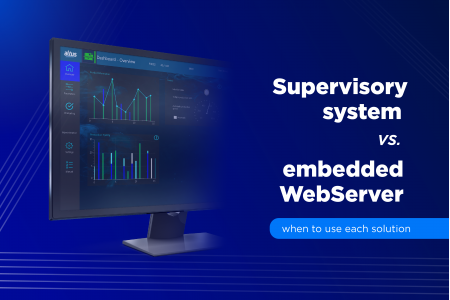
Ring Topology with PROFINET MRP
PROFINET is one of the most widely used communication protocols in industrial control and supervision networks. Responsible for establishing communication between systems and devices in about 20% of automation applications globally, the protocol is heavily utilized in critical process control that requires high availability. One feature that ensures this high reliability is the PROFINET MRP standard for ring architecture.
Are you familiar with this feature? In this article, we`ll delve into the relationship between the PROFINET protocol and the MRP standard, exploring how they can be used to create ring topology that provide high availability for control and supervision systems.
What is the PROFINET Protocol?
Developed by PROFIBUS & PROFINET International (PI), PROFINET is one of the most utilized protocols worldwide, especially in Europe. The standard facilitates the exchange of large volumes of data using the same electrical model adopted by traditional Ethernet networks.
This integration has opened a range of automation solutions, thanks to Ethernet`s data traffic management and high-speed capabilities. PROFINET`s open profile covers all industrial automation technology requirements. It is fully compatible with IEEE standards and meets system requirements with its flexible topology.
By using the PROFINET protocol, it is possible to build transparent communication between management, supervision, control, and field devices, all while respecting the performance requirements peculiar to each piece of industrial automation equipment.
Like PROFIBUS, PROFINET is widely used in the process industry and can be found on the factory floor, in transducers, transmitters, and various other devices. With different standards, the PROFINET model supports a wide variety of Industrial Ethernet networks. Below, we briefly explore each of them concerning their characteristics and applications.
The Different Types of PROFINET Protocols
PROFINET I/O (Input/Output): Used for data communication between input and output devices and PLCs, it is the most applied standard in industrial automation for field device control and supervision.
PROFINET RT (Real-Time): The RT standard offers real-time communication, making it ideal for industrial applications that require fast communication without exact synchronization needs.
PROFINET IRT (Isochronous Real-Time): An extension of PROFINET RT, this protocol offers deterministic real-time communication with high temporal precision. Ideal for applications requiring strict synchronization and low latency, such as motion control in machinery, robotics, and high-speed process automation.
PROFINET CBA (Component-Based Automation): This standard has a component-based approach that allows modular and reusable automation system configurations, facilitating integration and maintenance. It is used for complex system automation, where modularity and component reusability are important.
PROFINET I/O Device Redundancy: This standard offers redundancy for input and output devices to ensure operational continuity in case of device failures. Essential in applications where system availability is crucial, it ensures that failures in one device do not interrupt the automation process.
PROFINET MRP (Media Redundancy Protocol): PROFINET MRP is a protocol offering media redundancy to ensure high network availability, allowing for rapid recovery in case of network failures. We will discuss this standard in more detail in the following paragraphs.
What is PROFINET MRP and How Does It Work?
PROFINET MRP, short for Media Redundancy Protocol, is a network protocol that can be used in most of the devices compatible with PROFINET technology. It allows configuring networks in a ring topology, creating small individual domains within large networks.
For an application using this topology to be possible, only devices with at least two Ethernet ports can be included in an MRP ring. For devices with more than two ports, it is necessary to configure which ports will be used as ring ports to establish the serial connection.
Configuring MRP in a ring topology requires all nodes to support MRP, and at least one of them must act as the network Manager, called the MRM (Media Redundancy Manager). Thus, if for any reason the transmission is interrupted, the ring manager can immediately activate alternative communication within milliseconds.
The MRM monitors and controls the ring topology, continuously sending test frames to traverse the entire network. These frames are forwarded through the ring ports of all Clients, called MRCs (Media Redundancy Clients).
An MRC is a device that acts only as a "pass-through" for frames and generally does not take an active role. If an MRC detects a failure, such as a connection drop, it can send a special message to the MRM informing about this failure, reducing the communication reconfiguration time.
The MRP ring is considered as two inline topologies where all clients remain connected to the manager. As long as the manager receives the test frame on its other port, it considers the network connections intact. In this scenario, the MRM blocks one of its ports, and data packets are transmitted in only one direction around the ring.
If a section of the ring is interrupted, the MRM stops receiving frames on both ports. It then informs the MRCs about the network error and activates its previously blocked ring port. Regardless of whether the interruption is caused by a network media error or one of the devices retransmitting data, after the network error is corrected and the ring topology is closed again, the MRM blocks its second ring port again, and the "closed ring scenario" is valid again.
Another way to increase network reliability is by using multiple MRMs in the same ring, anticipating the possibility of the main manager failing. In this case, all possible managers must be configured as auto-manager. Only one of the devices configured as auto-manager will actually function as the manager, while the rest will operate as clients.
Altus Manual for using PROFINET protocol
To help you maximize the capabilities of your PROFINET control networks, our R&D team has developed a comprehensive manual on the protocol. It contains detailed technical descriptions to help you understand the complexities of PROFINET communication concepts, providing a solid foundation for implementing PROFINET in applications using Altus PLCs.
Fill out the form below to download the manual and further enhance your experience with Altus PLCs and the PROFINET protocol.
Advantages of Using a Ring Architecture
Ring architecture is a type of network configuration where devices are connected circularly, forming a closed loop. In this arrangement, each device is linked to exactly two other network members, creating a continuous path for data transmission. This means data travels in only one direction around the ring, passing through each device until reaching its destination.
In a ring architecture, data is transmitted sequentially from one device to the next. When you send data from your device, it travels to the next network member in the ring, and this equipment passes it on to the next until the data reaches the final recipient. Each device in the ring acts as a repeater, retransmitting data and ensuring it continues to flow around the ring.
An advantage of ring topology is that it provides equal access to all devices on the network. Since data travels in a circular path, each device has the same opportunity to send and receive data. Additionally, ring networks can handle large data loads more efficiently because each device has dedicated time slots to transmit data, reducing the chances of collisions.
PROFINET MRP Ring Network with NX3008 CPU
Created to meet the demands of an increasingly connected industry, the NX3008 CPU has a wide variety of communication interfaces capable of connecting the equipment to various systems and machines on the market. The most advanced control device in the Nexto Series has three Ethernet ports, two of which support the PROFINET Controller communication protocol, allowing the controller to be used in an MRP ring network.
Fully IoT-compliant, the CPU also has direct write capabilities to SQL databases and direct interaction with the most relevant cloud hosting services, such as Microsoft Azure, IBM Cloud, Google One, and Amazon AWS. The unit also features an embedded WebServer, a tool that allows creating application supervision and monitoring screens without using a SCADA system.
Another unique feature of the unit is the embedded VPN, which creates a private connection tunnel directly to the CPU. This functionality allows you to access your business control network remotely and securely. To further enhance the product`s security, the CPU has a firewall feature.
The CPU also supports FTP connections, enabling the device to exchange data with a server using this technology model. This functionality allows data packets generated by the controller, such as logs collected through a datalogger function, to be accessed remotely.
A new feature available is its embedded Docker platform. Native to the CPU, this resource makes it possible to virtualize software developed for Unix operating systems. The feature gives more versatility and speed to system operation, allowing multiple data processing within the CPU.
Click the banner below to visit the official NX3008 page, a global product with advanced software and cybersecurity capabilities that can dynamically integrate IT and OT areas in an industry.





